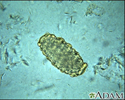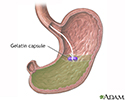String test
Duodenal parasites test; Giardia - string test
A string test involves swallowing a string to obtain a sample from the upper part of the small intestine. The sample is then tested to look for intestinal parasites.
How the Test is Performed
To have this test, you swallow a string with a weighted gelatin capsule on the end. The string is pulled out 4 hours later. Any bile , blood, or mucus attached to the string is examined under the microscope. This is done to look for cells and parasites or parasite eggs.
Bile
Bile is a fluid that is made and released by the liver and stored in the gallbladder. Bile helps with digestion. It breaks down fats into fatty acid...

How to Prepare for the Test
You may be asked not to eat or drink anything for 12 hours before the test.
How the Test will Feel
You may find it hard to swallow the string. You may have an urge to vomit when the string is being removed.
Why the Test is Performed
The test is performed when your health care provider suspects that you have a parasite infection. Usually a stool sample is tested first. A string test is done if the stool sample is negative.
Normal Results
No blood, parasites, fungi, or abnormal cells is normal.
Normal value ranges may vary slightly among different laboratories. Talk to your provider about the meaning of your test results.
What Abnormal Results Mean
Abnormal results may be a sign parasite infection such as giardia .
Giardia
Giardia, or giardiasis, is an infection of the small intestine. A tiny parasite called Giardia lamblia causes it.

Considerations
Treatment with certain drugs can affect the test results.
References
Beavis, KG, Charnot-Katsikas, A. Specimen collection and handling for diagnosis of infectious diseases. In: McPherson RA, Pincus MR, eds. Henry's Clinical Diagnosis and Management by Laboratory Methods . 23rd ed. Philadelphia, PA: Elsevier; 2017:chap 64.
Bope ET, Kellerman RD. The infectious diseases. In: Bope ET, ed. Conn's Current Therapy 2016 . Philadelphia, PA: Elsevier; 2016:chap 3.
Haines CF, Sears CL. Infectious enteritis and proctocolitis. In: Feldman M, Friedman LS, Brandt LJ, eds. Sleisenger and Fordtran's Gastrointestinal and Liver Disease . 10th ed. Philadelphia, PA: Elsevier Saunders; 2016:chap 110.
Hall GS, Woods GL. Medical bacteriology. In: McPherson RA, Pincus MR, eds. Henry's Clinical Diagnosis and Management by Laboratory Methods . 23rd ed. Philadelphia, PA: Elsevier; 2017:chap 58.
Hill DR, Nash TE. Giardia lamblia. In: Bennett JE, Dolin R, Blaser MJ, eds. Mandell, Douglas, and Bennett's Principles and Practice of Infectious Diseases . 8th ed. Philadelphia, PA: Elsevier Saunders; 2015:chap 281
Siddiqi HA, Salwen MJ, Shaikh MF. Laboratory diagnosis of gastrintestinal and pancreatic disorders. In: McPherson RA, Pincus MR, eds. Henry's Clinical Diagnosis and Management by Laboratory Methods . 23rd ed. Philadelphia, PA: Elsevier; 2017:chap 22.
-
Ascaris lumbricoides egg - illustration
Ascaris lumbricoides
Ascaris lumbricoides egg
illustration
-
Gelatin capsule in stomach - illustration
A string test is performed to detect the presence of intestinal parasites. A weighted gelatin capsule attached to a string is swallowed and left in place. After about 4 hours, the gelatin capsule is pulled out of the stomach by the string. Any bile, blood, or mucus remaining on the string is examined under the microscope for cell types and segments of parasites or eggs.
Gelatin capsule in stomach
illustration
-
Ascaris lumbricoides egg - illustration
Ascaris lumbricoides
Ascaris lumbricoides egg
illustration
-
Gelatin capsule in stomach - illustration
A string test is performed to detect the presence of intestinal parasites. A weighted gelatin capsule attached to a string is swallowed and left in place. After about 4 hours, the gelatin capsule is pulled out of the stomach by the string. Any bile, blood, or mucus remaining on the string is examined under the microscope for cell types and segments of parasites or eggs.
Gelatin capsule in stomach
illustration
Review Date: 5/11/2016
Reviewed By: Subodh K. Lal, MD, gastroenterologist with Gastrointestinal Specialists of Georgia, Austell, GA. Review provided by VeriMed Healthcare Network. Also reviewed by David Zieve, MD, MHA, Isla Ogilvie, PhD, and the A.D.A.M. Editorial team.


